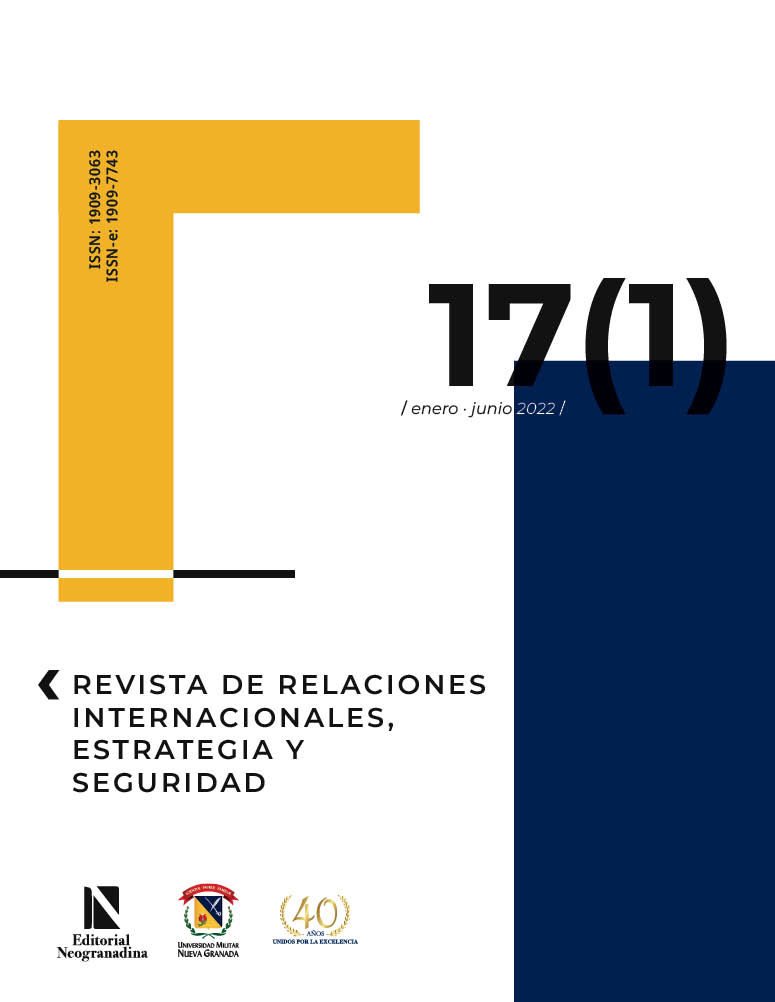Poder militar y disuasión convencional
revisión de la literatura
Resumen
Esta revisión de la literatura explica la forma en que las estrategias de disuasión y coacción (compellence) se relacionan con el poder militar. Tal investigación es pertinente, puesto que gran parte de la literatura sobre la difusión del poder militar se centra exclusivamente en las plataformas militares y en los sistemas de armas. Por lo tanto, se promueve un enfoque más político y estratégico en lugar de un enfoque más tecnológico al evaluar el poder militar. En el artículo, se utiliza “costos” y “probabilidad de éxito” para evaluar la disuasión convencional. Aunque tanto la coacción como la disuasión son estrategias coercitivas, tienen diferentes implicaciones para la difusión del poder militar, en especial por los costos asociados a cada una. También se argumenta que los países no deberían replicar o copiar todas las plataformas principales y sistemas de armas avanzados de un estado líder para actualizarse o negar las ventajas de la innovación tecnológica. En consecuencia, las estrategias de negación son mucho más económicas que las estrategias de control. Por último, las estrategias de negación a menudo disminuyen la probabilidad de éxito en el campo de batalla de una ofensiva de la fuerza expedicionaria. Se concluye que el poder militar debe relacionarse mucho más con la disuasión que con la coacción para contrarrestar la noción convencional de Dahl de que el poder es la capacidad de “A” para hacer que “B” haga algo que “B” de otro modo no haría. En otras palabras, el poder militar debe verse como “A” convenciendo a “B” de no iniciar una acción específica porque los beneficios percibidos para “B” no justifican los costos y riesgos potenciales.
Descargas
Referencias bibliográficas
Adamsky, D. (2021). Moscow’s Aerospace Theory of Victory: Western Assumptions and Russian Reality. Washington: CNA.
Ajili, H. & and Rouhi, M. (2019). Iran’s Military Strategy. Survival 61 (6): 139-52. DOI: https://doi.org/10.1080/00396338.2019.1688575
Altman, D. (2017). By Fait Accompli, Not Coercion: How States Wrest Territory from Their Adversaries. International Studies Quarterly, 61 (4): 881–891. DOI: https://doi.org/10.1093/isq/sqx049
Anthony, I. (2009). The role of deterrence in future NATO strategy. Stockholm: Stockholm International Peace Research Institute.
Aust, T. (2018). Modernized Deterrence and Revitalized Dialogue: Adapting the Harmel Report to Post-2014 Europe. Research Paper 146. Rome: NATO Defense College. https://www.ndc.nato.int/news/news.php?icode=1182.
Beckley, M. (2017). The Emerging Military Balance in East Asia: How China’s Neighbors Can Check Chinese Naval Expansion. International Security, 42(2), 78-119. DOI: https://doi.org/10.1162/ISEC_a_00294
Biddle, S. & Oelrich, I. (2016). Future Warfare in the Western Pacific: Chinese A2/AD, U.S. ASB, and Command of the Commons in East Asia. International Security, 41(1), 7-48. DOI: https://doi.org/10.1162/ISEC_a_00249
Biddle, S. (2006). Military Power: Explaining Victory and Defeat in Modern Battle. Princeton: Princeton University Press.
Borresen, J. (1994). The seapower of the coastal state. Journal of Strategic Studies, 17(1), 148-175. DOI: https://doi.org/10.1080/01402399408437544
Bowen, B. (2020). War in Space: Strategy, Spacepower, Geopolitics. Edinburgh: Edinburgh University Press. DOI: https://doi.org/10.1515/9781474450508
Bowers, I. & Kirchberger, S. (2020). Not so disruptive after all: The 4IR, navies and the search for sea control, Journal of Strategic Studies. DOI: https://doi.org/10.1080/01402390.2020.1848819
Bowers, I. (2018). Small State Deterrence in the Contemporary World. Oslo: Norwegian Institute for Defence Studies.
Bredesen, M.G. & Friis, K. (2020). Missiles, Vessels and Active Defence. The RUSI Journal, 165(5-6), 68-78. DOI: https://doi.org/10.1080/03071847.2020.1829991
Caverley, J.D. & Dombrowski, P. (2020). Cruising for a Bruising: Maritime Competition in an Anti-Access Age, Security Studies, 29(4), 671-700. DOI: https://doi.org/10.1080/09636412.2020.1811460
Cepik, M., & Bertol, F. L. (2016). Defense policy in Brazil: Bridging the gap between ends and means? Defense Studies, 16(3), 229-247. DOI: https://doi.org/10.1080/14702436.2016.1180959
Chin, W. (2019). Technology, War and the State: Past, Present and Future. International Affairs 95 (4): 765-83. DOI: https://doi.org/10.1093/ia/iiz106
Colby, E. & Solomon, J. (2015). Facing Russia: Conventional Defence and Deterrence in Europe. Survival, 57(6), 21-50. DOI: https://doi.org/10.1080/00396338.2015.1116146
Covarrubias, J.G. (2004). The Significance of Conventional Deterrence in Latin America, Military Review, March-April, 36-39.
Dahl, R. (1957). The Concept of Power. Behavioral Science, 2(3), 201-15. DOI: https://doi.org/10.1002/bs.3830020303
Davis, P. (2014). Toward Theory for Dissuasion (or Deterrence) by Denial: Using Simple Cognitive Models of the Adversary to Inform Strategy, RAND Corporation, January: 121.
Duarte, É. (2012). A Conduta da Guerra na Era Digital e suas Implicações para o Brasil: Uma Análise de Conceitos, Políticas e Práticas de Defesa. Texto Para Discussão (IPEA), Junho. http://www.ipea.gov.br/portal/index.php?option=com_content&view=article&id=15290
Duarte, É. (2015). Securing the South Atlantic: In Favour of a Revised Brazilian Maritime Strategy. In B. Smith-Windsor (Ed.), Enduring NATO, Rising Brazil. Rome: NATO Defence College.
Dunnigan, J. (2003). How to Make War: A Comprehensive Guide To Modern Warfare In The Twenty-First Century. New York: HarperCollins.
Fravel, T. (2019). Active Defense: China’s Military Strategy since 1949. Princeton: Princeton University Press. DOI: https://doi.org/10.1515/9780691185590
Freedman, L. (2004). Deterrence. Cambridge: Polity Press.
Freedman, L. (2014). Ukraine and the Art of Limited War. Survival 56 (6): 7–38. DOI: https://doi.org/10.1080/00396338.2014.985432
Galbreath, D.J. (2014). Western European Armed Forces and the Modernisation Agenda: Following or Falling Behind? Defence Studies 14 (4): 394–413. DOI: https://doi.org/10.1080/14702436.2014.961356
Gallagher, M. (2019). State of (Deterrence by) Denial. The Washington Quarterly, 42(2), 31-45. DOI: https://doi.org/10.1080/0163660X.2019.1626687
Gartzke, E. & Lindsay J. (2020). The Influence of Sea Power on Politics: Domain- and Platform-Specific Attributes of Material Capabilities. Security Studies, 29(4), 601-636. DOI: https://doi.org/10.1080/09636412.2020.1811450
Gilli, A. & Gilli, M. (2016). The Diffusion of Drone Warfare? Industrial, Organizational, and Infrastructural Constraints. Security Studies 25 (1): 50–84. DOI: https://doi.org/10.1080/09636412.2016.1134189
Gilli, A. & Gilli, M. (2019). Why China Has Not Caught Up Yet: Military-Technological Superiority and the Limits of Imitation, Reverse Engineering, and Cyber Espionage. International Security, 43(3), 141-189. DOI: https://doi.org/10.1162/isec_a_00337
Goldman, E.O. & Eliason, L.C. (2003). The Diffusion of Military Technology and Ideas. Stanford, Calif: Stanford University Press.
Gordon, J. et al. (2020). Army Fires Capabilities for 2025 and Beyond. Santa Monica, Calif: RAND Corporation. DOI: https://doi.org/10.7249/RR2124
Gormley, D.M. (2008). Missile Contagion. Survival 50 (4): 137–54. DOI: https://doi.org/10.1080/00396330802329006
Gray, C.S. (1990). The Definitions and Assumptions of Deterrence: Questions of Theory and Practice. Journal of Strategic Studies, 13(4), 1-18. DOI: https://doi.org/10.1080/01402399008437428
Gray, C.S. (2011). Hard Power and Soft Power: The Utility of Military Force as an Instrument of Policy in the 21st Century. Carlisle: US Army War College. DOI: https://doi.org/10.21236/ADA542526
Green, B.R. & Long, A. (2020). Conceal or Reveal? Managing Clandestine Military Capabilities in Peacetime Competition, International Security, 44 (3), 48-83. DOI: https://doi.org/10.1162/isec_a_00367
Gruselle, B. (2006). Cruise Missiles & Anti-Access Strategies. Paris: Fondation pour la Recherche Stratégique.
Harvey, J. (1997). Conventional Deterrence and National Security. Edited by Air Power Studies Centre. Fairbairn: Commonwealth of Australia.
Herz, M., Dawood, L. & Lage V.C. (2017). A Nuclear Submarine in the South Atlantic: The Framing of Threats and Deterrence. Contexto Internacional, 39(2), 329-350. DOI: https://doi.org/10.1590/s0102-8529.2017390200007
Horowitz, M. (2010). The Diffusion of Military Power: Causes and Consequences for International Politics. Princeton: Princeton University Press. DOI: https://doi.org/10.1515/9781400835102
Hughes, W. & Girrier, R. (2018). Fleet Tactics and Naval Operations (3rd ed.). Annapolis: Naval Institute Press.
Johnson, J. (2017). China's “Guam Express” and “Carrier Killers”: The anti-ship asymmetric challenge to the U.S. in the Western Pacific. Comparative Strategy, 36(4), 319-332. DOI: https://doi.org/10.1080/01495933.2017.1361204
Kashin, V. & Raska, M. (2017). Countering the U.S. Third Offset Strategy: Russian Perspectives, Responses and Challenges. Singapore: RSIS Policy Papers. (Policy Report, January).
Kelly, T. Gompert, D. & Long D. (2016). Smart Power, Stronger Partners: Exploiting U.S. Advantages to Prevent Aggression. Santa Monica, Calif.: RAND Corporation. DOI: https://doi.org/10.7249/RR1359
Klein, J. (2004) Corbett in Orbit. Naval War College Review, 57(1), 59-74.
Knopf, J. (2009). Three Items in One: Deterrence as Concept, Research Program, and Political Issue. In Paul, T. V., Morgan, P. & Wirtz, J. (Eds.), Complex Deterrence: Strategy in the Global Age (pp. 31-57). Chicago: The University of Chicago Press.
Kofman, M. (2020). Getting the Fait Accompli Problem Right in U.S. Strategy. War on The Rocks. From https://warontherocks.com/2020/11/getting-the-fait-accompli-problem-right-in-u-s-strategy
Kulesa, Ł. & Frear, T. (2017). NATO’s Evolving Modern Deterrence Posture: Challenges and Risks (Deterrence) [ELN Issue Brief]. European Leadership Network.
Kuo, K. (2020). Military Innovation and Technological Determinism: British and US Ways of Carrier Warfare, 1919–1945. Journal of Global Security Studies, 1-19. DOI: https://doi.org/10.1093/jogss/ogaa046
Lanoszka, A. & Hunzeker, M. (2019). Conventional Deterrence and Landpower in Northeastern Europe. Strategic Studies Institute.
Long, A. (2008). Deterrence From Cold War to Long War: Lessons from Six Decades of RAND Research. Santa Monica, CA: Rand Publishing.
Mahken, T.G. (2011) Weapons: The Growth & Spread of the Precision-Strike Regime. Dædalus, 140(3), 45-57. DOI: https://doi.org/10.1162/DAED_a_00097
Mearsheimer, J.J. (1981). The Theory and Practice of Conventional Deterrence. Cornell University, Ithaca.
Mearsheimer, J.J. (1986) A Strategic Misstep: The Maritime Strategy and Deterrence in Europe. International Security, 11(2), 3-57. DOI: https://doi.org/10.2307/2538957
Michaels, J.H. (2020). Visions of the next war or reliving the last one? Early alliance views of war with the Soviet Bloc. Journal of Strategic Studies, 43(6-7), 990-1013. DOI: https://doi.org/10.1080/01402390.2020.1759554
Mishra, S. (2011). Cruise missiles : evolution, proliferation, and future. New Delhi: Centre for Air Power Studies.
Montgomery, E. (2014). Contested Primacy in the Western Pacific China’s Rise and the Future of U.S. Power Projection. International Security, 38(4), 115-149. DOI: https://doi.org/10.1162/ISEC_a_00160
Morgan, P. (2021). Deterrence by Denial from the Cold War to the 21st Century.” In Wilner, A.S & Wegner, A. (eds). Deterrence by Denial: Theory and Practice. Amherst: Cambria Press.
Mueller, K. (1991). Strategy, Asymmetric Deterrence, and Accommodation: Middle Powers and Security in Modern Europe. Princeton University.
Nicholls, D. (2000). Cruise Missiles and Modern War: Strategic and Technological Implications. Montgomery: Center for Strategy and Technology.
Ochmanek, D. (2014). The Role of Maritime and Air Power in DoD’s Third Offset Strategy. US House of Representatives: RAND Corporation. https://www.rand.org/pubs/testimonies/CT420.html.
Paul, TV. 2009. Complex Deterrence: An Introduction. In Paul, T.V, Morgan, P. & Wirtz, J. (eds.) Complex Deterrence: Strategy in the Global Age. Chicago: University of Chicago Press. DOI: https://doi.org/10.7208/chicago/9780226650043.001.0001
Posen, B. (2003). Command of the Commons: the Military Foundation of U.S. Hegemony. International Security, 28(1), 5-46. DOI: https://doi.org/10.1162/016228803322427965
Petersen, M.B. (2020). Strategic Deterrence, Critical Infrastructure, and the Aspiration-Modernization Gap in the Russian Navy. Center for Strategic and International Studies
Rogers, E. (1983). Diffusion of Innovations. New York: The Free Press.
Rogovoy, A.V. & Giles, K. (2015). A Russian View On Landpower. Carlisle: US Army War College.
Schelling, T. (2008). Arms and Influence. New Haven: Yale University Press.
Schenoni, L.L. (2019). Bipolarity or Hegemony? Latin America’s Dilemma for the 21st Century. E-IR. https://www.e-ir.info/2019/02/24/bipolarity-or-hegemony-latin-americas-dilemma-for-the-21st-century/
Schmid, J. (2018). The Diffusion of Military Technology. Defence & Peace Economics 29 (6): 595–613. DOI: https://doi.org/10.1080/10242694.2017.1292203
Shugart, T. & Gonzalez, J. (2017). First Strike: China’s Missile Threat to U.S. Bases in Asia. Center for New American Century.
Snyder, G.H. (1961). Deterrence and Defense. Princeton University Press. DOI: https://doi.org/10.1515/9781400877164
Snyder, G.H. (1970). Deterrence: A Theoretical Introduction. In Garnett, J. (Eds.), Theories of Peace and Security (pp. 106-112). London: Macmillan. DOI: https://doi.org/10.1007/978-1-349-15376-3_6
Tangredi, S. (2013). Anti-Access Warfare Countering A2/AD Strategies. Annapolis: Naval Institute Press.
Teixeira, A. et al. (2020). Existe um sistema A2/AD na Venezuela? Revista de Geopolítica, 11(3), 28-42.
Tripp, B. (2020). Deterrence and Drones: Are Militaries Becoming Addicted and What Is the Prognosis? In Filippidou, A. (eds). Deterrence: Concepts And Approaches For Current And Emerging Threats. Cham: Springer. DOI: https://doi.org/10.1007/978-3-030-29367-3_7
Wilkinson, E. (2020). Resilience and Deterrence: Exploring Correspondence Between the Concepts. In Filippidou, A. (eds). Deterrence: Concepts And Approaches For Current And Emerging Threats. Cham: Sportverlag. DOI: https://doi.org/10.1007/978-3-030-29367-3_2
Wilner, A.S. & Wenger, A. (2021). Introduction. In Wilner, A.S & Wegner, A. (eds). Deterrence by Denial: Theory and Practice. Amherst: Cambria Press.
Yoshihara, T. & Holmes, J. (2018). Red Star over Pacific: China’s Rise and the Challenge to US Maritime Strategy (2nd ed.). Annapolis: Naval Institute Press.
Zhao, T. (2020). Conventional long-range strike weapons of US allies and China’s concerns of strategic instability, The Nonproliferation Review. DOI: https://doi.org/10.1080/10736700.2020.1795368
Datos de los fondos
-
Coordenação de Aperfeiçoamento de Pessoal de Nível Superior
Números de la subvención 88882439831/2019-01 -
Coordenação de Aperfeiçoamento de Pessoal de Nível Superior
Números de la subvención PROCAD-DEF20191322409P
Derechos de autor 2022 Revista de Relaciones Internacionales, Estrategia y Seguridad

Esta obra está bajo una licencia internacional Creative Commons Atribución-NoComercial-SinDerivadas 4.0.












